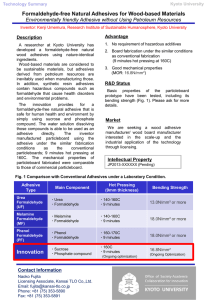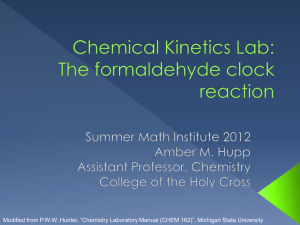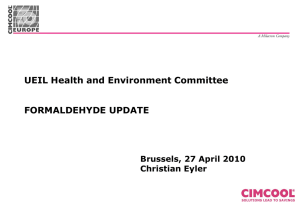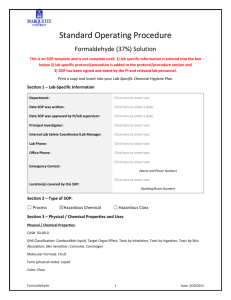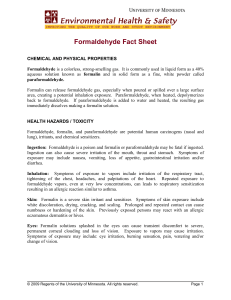Work related asthma from cleaning products
advertisement
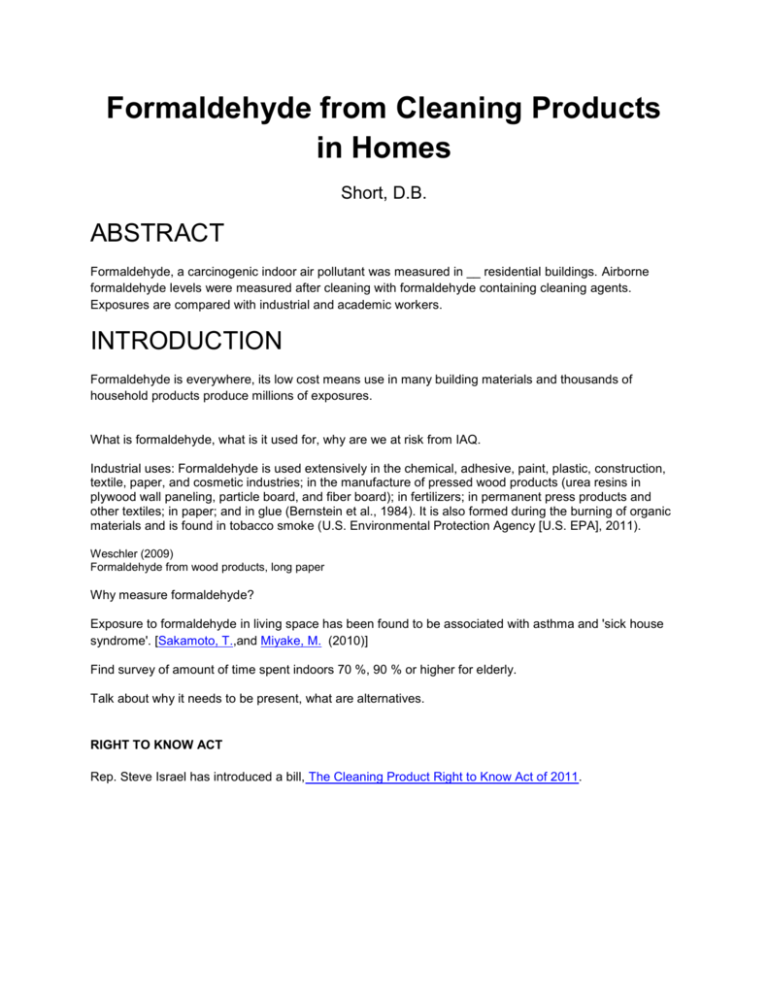
Formaldehyde from Cleaning Products in Homes Short, D.B. ABSTRACT Formaldehyde, a carcinogenic indoor air pollutant was measured in __ residential buildings. Airborne formaldehyde levels were measured after cleaning with formaldehyde containing cleaning agents. Exposures are compared with industrial and academic workers. INTRODUCTION Formaldehyde is everywhere, its low cost means use in many building materials and thousands of household products produce millions of exposures. What is formaldehyde, what is it used for, why are we at risk from IAQ. Industrial uses: Formaldehyde is used extensively in the chemical, adhesive, paint, plastic, construction, textile, paper, and cosmetic industries; in the manufacture of pressed wood products (urea resins in plywood wall paneling, particle board, and fiber board); in fertilizers; in permanent press products and other textiles; in paper; and in glue (Bernstein et al., 1984). It is also formed during the burning of organic materials and is found in tobacco smoke (U.S. Environmental Protection Agency [U.S. EPA], 2011). Weschler (2009) Formaldehyde from wood products, long paper Why measure formaldehyde? Exposure to formaldehyde in living space has been found to be associated with asthma and 'sick house syndrome'. [Sakamoto, T.,and Miyake, M. (2010)] Find survey of amount of time spent indoors 70 %, 90 % or higher for elderly. Talk about why it needs to be present, what are alternatives. RIGHT TO KNOW ACT Rep. Steve Israel has introduced a bill, The Cleaning Product Right to Know Act of 2011. TOCIXOLOGY: Known International Agency for Research on Cancer (IARC) group 1 carcinogen (known to be carcinogenic to humans). Same group as benzene, arsenic, asbestos, ionizing radiation. LEVELS: European regulators have been active and the California Air Resources Board (CARB) has taken its own initiatives. But even CARB has only made recommendations - "...highly desirable that residential levels remain well below 27 ppb (0.02 ppm)." The problem of avoiding formaldehyde is exacerbated by the many decay reaction partial products and product names it hides under. Here is a partial list of tell-tales; methanal, methylene oxide, oxymethyline, methylaldehyde, oxomethane, formalin, and morbicid acid. methylene glycol, or formaldehyde releasing preservatives, DMDM Hydantoin, Urea, quaternium15, 2 Bromo-2 nitropane- 1,3 Diol, 5-Bromo-5-Nitro-1,3 Dioxane, and Methenamine. The comparison to health guidelines showed that formaldehyde concentrations were above the chronic (R.. Exposure Level) RELs required by the OEHHA(?) (9 μg/m 3) Wu et al (2011) 0.1 ppm is recommended American Society for Heating, Refrig and Air Conditioing Engineers (ASHRAE), American Industrial Hygiene Association (AIHA) and EPA limit for mobile homes [Sexton et al 1989] The toxic effects of formaldehyde exposure can be classified as follows: irritation of mucous membrane, contact dermatitis, teratogenicity, and carcinogenicity (National Institute for Occupational Safety and Health [NIOSH], 2009). Toxicology of IAQs, this one would be one of most dangerous. Which IAQs are group 1 carcinogens? Asbestos, radon etc What category are particulates, carbon monoxide etc. SOURCES IN THE HOME: 2 Main ‘new’ sources from cleaning agents 1) As a biocide [Hahn et al 2010] 2) As a reaction product (secondary pollutant) [Nazaroff, W.W 2004] Listed here http://www.sciencedaily.com/releases/1999/01/990104073541.htm Singer, B.C.,Coleman, B.K.,Destaillats, H.,Hodgson, A.T., Lunden, M.M., Weschler, C.J., Nazaroff, W.W.bc (2006) Indoor secondary pollutants from cleaning product and air freshener use in the presence of ozone. Atmospheric Environment, Volume 40, Issue 35, November 2006, Pages 6696-6710 Recent list of products http://consumerist.com/2009/03/baby-products-now-with-formaldehyde.html Hahn, 2010 Formaldehyde releasing agents (Hahn et al 2010) – what the heck is this? Do they mean precursors Background levels: Singer BC et al 2006 Formaldehyde production from ozone leads to levels of 0.01 ppm, this is where the background comes from Example reaction: from EChem notes CxHyOz + O3 → HCHO e.g. ethyl acetate, CH3COOCH2CH3 e.g. acetone, (CH3)2CO e.g. glycol ether, CH3OCH2CH2OH Morrison, G.C. and W.W. Nazaroff; "Ozone interactions with carpet: secondary emissions of aldehydes." Environmental Science Technology 36: 2185-2192, 2002. Weschler, C. J., A. T. Hodgson and J. D. Wooley; "Indoor Chemistry: Ozone, Volatile organic compounds and carpets." Environmental Science Technology 26: 2371-2377, 1992. A 4 % increase in formaldehyde levels was pointed out when 8-hour ozone concentrations increased by 20μg/m 3. Rancière, F.,Dassonville, C.,Roda, C.,Laurent, A.-M.,Le Moullec, Y.,Momas, I. (2011) Contribution of ozone to airborne aldehyde formation in Paris homes. Science of the Total Environment , Volume 409, Issue 20, 15 September 2011, Pages 4480-4483 Higher levels of indoor pollutants in airtight homes, ACH-50 < 5. Newer homes tend to be airtight, remediation choices include removing source of formaldehyde or increasing ventilation. Check this ref to see if they did this: Hun, D.E.,Corsi, R.L.,Morandi, M.T.,Siegel, J.A. (2010) Formaldehyde in residences: Long-term indoor concentrations and influencing factors. Indoor Air, Volume 20, Issue 3, June 2010, Pages 196-203 Campus levels Weng, M. (2012) Levels and possible sources of formaldehyde in campus ( Conference Paper ). 3rd international Conference on Manufacturing Science and Engineering, ICMSE 2012;Xiamen;27 March 2012through29 March 2012;Code89075.Advanced Materials Research., Volume 479-481, 2012, Pages 546-549. New decoration in China: Concentration of formaldehyde was ranging from 0.01 to 0.31 mg/m3 Xue, S.-G. ,Ma, Y.-M.,Li, L.-J.,Huang, Y.-H.,Wang, J. (2011) Investigation of indoor formaldehyde pollution in newly decorative residences. Tumu Jianzhu yu Huanjing Gongcheng/Journal of Civil, Architectural and Environmental Engineering, Vol. 33, No. 3, pp.124-128. 40 % of indoor formaldehyde from building materials: Missia, D.A. ,Demetriou, E.,Michael, N.,Tolis, E.I., and Bartzis, J.G. (2010) Indoor exposure from building materials: A field study. Atmospheric Environment, Volume 44, Issue 35, November 2010, Pages 43884395 Noncancer effects: Concentrations of FA, both personal and stationary, are on average in the order of 0.05mg/m3 or less in Europe and North America with the exception of new housing or buildings with extensive wooden surfaces, where the concentration may exceed 0.1mg/m3. Wolkoff, P. ,Nielsen, G.D. (2010) Non-cancer effects of formaldehyde and relevance for setting an indoor air guideline (Review ). Environment International, Volume 36, Issue 7, October 2010, Pages 788799. Cleaning products and air fresheners can produce formaldehyde. UC Berkeley researchers found that chemicals in pine oils and citrus oils react with ozone in the air, producing formaldehyde. From: ‘Pick Your Poison’ by Rossol, M Pine and citrus oils can react with ozone from outside AND ozone from ozone generators some people use to ‘purify air’. http://books.google.com/books?id=C0nLOMfdY_sC&pg=PT94&lpg=PT94&dq=pine+oils+and+citrus+oils+react+ with+ozone+in+the+air&source=bl&ots=z6WS_sK1lf&sig=RB6dL1qA1ViNcqa1ALGd5OtxFOs&hl=en&sa=X&e i=vH56T6CwAuPo0QHQxP3BQ&ved=0CB4Q6AEwAA#v=onepage&q=pine%20oils%20and%20citrus%20oils%20react%20with%20ozone%2 0in%20the%20air&f=false Full Ref is from 2004 EXPERIMENTAL DISCUSSION Levels of formaldehyde in homes exposed to formaldehyde or formaldehyde precursors were found to be… This is comparable to the 0.017 ppm levels found by Hun (2011) in 179 homes. The background indoor/outdoor formaldehyde level is likely to be 0.01 ppm or above due to the oxidation of formaldehyde precursors. The mean background formaldehyde measured in this study was _____. Can be removed with activated charcoal filtration and trapping agents [Sekine et al 2011] Future: measure ozone ppb concentrations with chemiluminescent O3 analyzer concurrently with formaldehyde. REFERENCES Work related asthma from cleaning products – Arif, A.A. and Delclos, G.A. (2012) Association between cleaning-related chemicals and work-related asthma and asthma symptoms among healthcare professionals. Occupational and Environmenal Medicine, Vol. 69, No. 1, pp. 35-40. Wu, X., Apt, M.G., Maddalena, R., and Bennett, D.H. (2011) Volatile organic compounds in small- and medium-sized commercial buildings in California. Environmental Science and Technology, Vol. 45, No. 20, pp. 9075-9083. Eisberg, N. (2010) Cleaning goes greener – removing formaldehyde preservatives, Chemistry and Industry (London) Issue 3, 8 February 2010, pp. 23-25. Exposure to formaldehyde in living space has been found to be associated with asthma and 'sick house syndrome'. Sakamoto, T.,and Miyake, M. (2010) Health effects of formaldehyde, as an indoor air pollutant. Kaibogaku zasshi. Journal of anatomy. Vol. 85, No. 1, pp. 35-41. Flyvholm, M.-A. (1997) Formaldehyde exposure at the workplace and in the environment (Review). Allergologie, Vol. 20, No. 5, pp. 225-231. Moldoveanu, A.M. and Decusara, M. (1998) Home exposure to some indoor air pollutants (Conference Paper). Central European Journal of Public Health. Vol. 6, No. 2, pp. 175-176 Becher, R.,Hongslo, J.K.,Jantunen, M.J., and Dybing, E. (1996) Environmental chemicals relevant for respiratory hypersensitivity: The indoor environment (Conference Paper). Toxicology Letters, Vol. 86, No. 2-3, pp. 155-162. Raja, D.S. and Sultana, B. (2012) Potential health hazards for students exposed to formaldehyde in the gross anatomy laboratory. Journal of Environmental Health, Vol. 74, No. 6, pp. 36-40. Lovreglio, P., Carrus, A., Iavicoli, S.,Drago, I.,Persechino, B. , and Soleo, L. (2009) Indoor formaldehyde and acetaldehyde levels in the province of Bari, South Italy, and estimated health risk. Journal of Environmental Monitoring. Vol. 11, No. 5, pp. 955-961. Weschler, C.J. (2009) Changes in indoor pollutants since the 1950s.Atmospheric Environment. Vol. 43, No. 1, pp. 153-169. Onyije, F.M. and Avwioro, O.G. (2012) Excruciating effect of formaldehyde exposure to students in gross anatomy dissection laboratory. International Journal of Occupational and Environmental Medicine. Vol. 3, No. 2, pp, 92-95. Kim, K.-H. ,Jahan, S.A.,Lee, J.-T. (2011) Exposure to formaldehyde and its potential human health Hazards. Journal of Environmental Science and Health - Part C Environmental Carcinogenesis and Ecotoxicology Reviews, Vol. 29, No. 4, pp. 277-299. Hun, D.E., Corsi, R.L., Morandi, M.T., and Siegel, J.A. (2010) Formaldehyde in residences: Long-term indoor concentrations and influencing factors. Indoor Air, Volume 20, No. 3, pp. 196-203. Lazenby, V., Hinwood, A., and Franklin, P. (2007) Personal exposure of children to formaldehyde ( Conference Paper). Proc. 14th International Union of Air Pollution Prevention and Environmental Protection Associations (IUAPPA) World Congress 2007, 18th Clean Air Society of Australia and New Zealand (CASANZ) Conf.;Brisbane, QLD;9 September 2007through13 September 2007; Code72094. Gustafson, P., Barregård, L.,Lindahl, R., and Sällsten, G.(2005) Formaldehyde levels in Sweden: Personal exposure, indoor, and outdoor concentrations. Journal of Exposure Analysis and Environmental Epidemiology, Vol. 15, No. 3, May 2005, Pages 252-260. Kelly, T.J., D.L. Smith, and J. Satola. 1999. Emission rates of formaldehyde from materials and consumer products found in California homes. Environmental Science & Technology 33(Jan. 1):81. Sexton, K., Petreas, M.X., and Lui, K-S. (1989) Formaldehyde Exposures inside Mobile Homes. Environmental Science and Technology, Vol. , No., pp. . Brett C. Singer, Beverly K. Coleman, Hugo Destaillatsb, , Alfred T. Hodgsonb, , Melissa M. Lundena, , Charles J. Weschlerd, e, William W Nazaroff (2006) Indoor secondarypollutants from cleaning product and air freshener use in the presence of ozone. Atmospheric Environment, Volume 40, Issue 35, November 2006, Pages 6696–6710. Nazaroff, W.W. and Weschler, C.J. (2004) Cleaning products and air fresheners: Exposure to primary and secondary air pollutants, Atmospheric Environment, Vol. 38, pp. 2841-2865. Hahn, S. ,Schneider, K. ,Gartiser, S.c ,Heger, W., Mangelsdorf, I. (2010) Consumer exposure to biocides-identification of relevant sources and evaluation of possible health effects. Environmental Health: A Global Access Science Source, Vol. 9, No. 1 Article number 7. Wegscheider, W.(2003) Measurements of formaldehyde exposure at workplaces in the health services (2003) Gefahrstoffe Reinhaltung der Luft, 63 (7-8), pp. 309-315. Berger-Preiß, E., Boehncke, A., Könnecker, G., Mangelsdorf, I., Holthenrich, D., Koch, W. Inhalational and dermal exposures during spray application of biocides (2005) International Journal of Hygiene and Environmental Health, 208 (5), pp. 357-372. Bagda, E., Brenner, T., Wensing, M. (1997) On formaldehyde emission from emulsion paints Farbe und Lack, 103 (8), pp. 87-91. Sekine, Y.,Fukuda, M.,Takao, Y., ,Ozano, T.,Sakuramoto, H., and Wang, K.W. (2011) Simultaneous removal of formaldehyde and benzene in indoor air with a combination of sorption-and decompositiontype air filters. Environmental Technology, Volume 32, Issue 16, 1, pp. 1983-1989.
